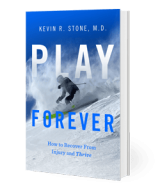Bone Spurs, Bone Gold
Bone spurs are the bane of the older person’s existence. They protrude from joints at the hands, knees, and feet and are often painful. But there is gold in those spurs—and here is why.

Bone spurs affect everyone—from young athletes with plantar fasciitis to women with bunions, to those afflicted with back pain produced by spurs digging into the spinal nerves. They can appear as bumps on the sides of the fingers, the heel, on the toe joints, and as protuberances that widen the knee joint. They form seemingly without cause, without clear purpose, and without any benefit at all. When we look at an X-ray of a bone spur, the affected joint may appear completely normal; or it may present as the narrowed, irregular, deformed joint of arthritis. Viewed on an MRI or CT scan the spur looks like normal bone, just in the wrong place. And when we open the joint (which we do by gentle surgical exposure), the bone spur has the same shiny white surface appearance of normal articular cartilage. When we cut off the spur, however, the bone beneath the cartilage cap may or may not have degenerated.
So why this curse? The formation of bone spurs may arise from traction or friction, as with the plantar fasciitis or the heel spur. The pull and rubbing motion on the underlying bone appear to stimulate bone formation. Other spurs—such as those in the knee joint—are most often associated with the two types of arthritis. The first is osteoarthritis, where there is an underlying disease state that produces abnormal synovium in the joint lining, cartilage metabolism, and bone degeneration. The second is traumatic arthritis, in which an injury has occurred to the overlying cartilage and bone (e.g., a fractured toe joint that wasn’t repaired), changing the way loads are shared in walking in running.
The evolutionary benefit of the bone spur is elusive, but it may have arisen from the body’s effort to diffuse the loading forces. By forming the spur at the edge of the joint, the surface area for joint loading is widened—effectively unloading the central aspect of the joint. This theory has problems, though, as the spurs often appear to be much more harmful than beneficial to joint mechanics.
Where is the good in all this? The positive side, and where the gold lies, is the fact that if the body can form perfectly normal-looking bone and cartilage outside of where it should be, all of the theories suggesting that cartilage cannot be successfully regenerated go out the window. And if new bone and cartilage can grow at the edges, why can’t we, as surgeons, induce it to grow in an injured area or on an arthritic surface? By studying spur formation, we learned years ago that we can indeed do this. A technique that we invented in the mid-1990s, called articular cartilage paste grafting, has successfully used this approach.
Our process of discovery began when we observed that the intercondylar notch of the knee joint (the center space where the ligaments called ACL and PCL travel) regrew naturally after we widened it in our ligament reconstruction procedures. The notch regrowth looked like a bone spur.
If bone could regrow there, we reasoned—and it appeared normal—why not elsewhere? We believed that if we could create a paste-like mixture of bone and cartilage taken from the intercondylar notch, with all its stimulating cells and growth factors, impact it into the area of damage, and apply motion (which is known to stimulate cartilage rather than bone formation), we could expect new cartilage to form. This technique worked and has now successfully repaired damaged joints in thousands of people.
The biology of the bone spur demonstrates that a specific stimulus that induces the body to regrow bone and cartilage in one area can be harnessed to do it in another. Our job is to learn the techniques of the body’s regenerative ability and mine the gold that lives in those bumps and spurs.
Cartilage Regeneration Using the Articular Cartilage Paste Graft Technique

